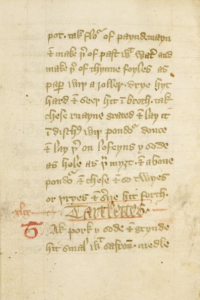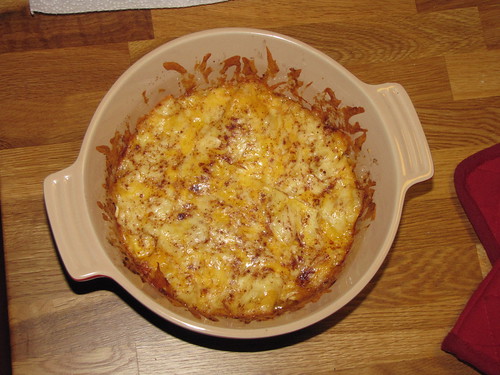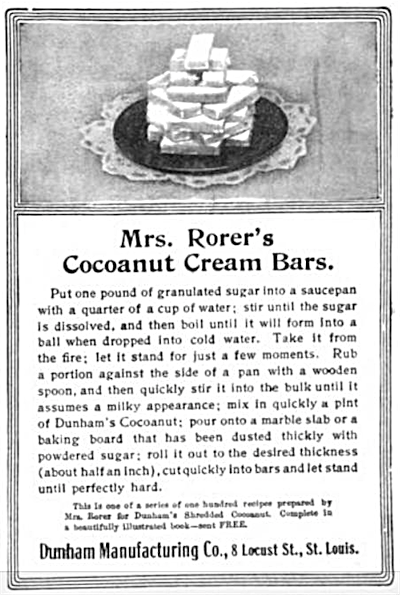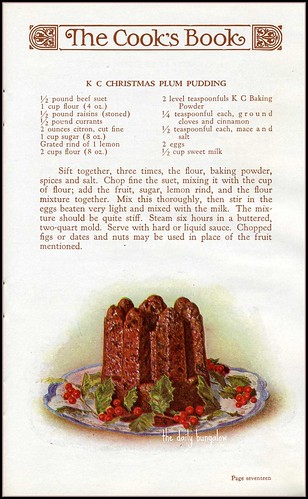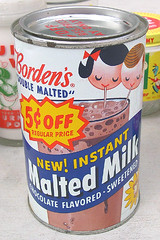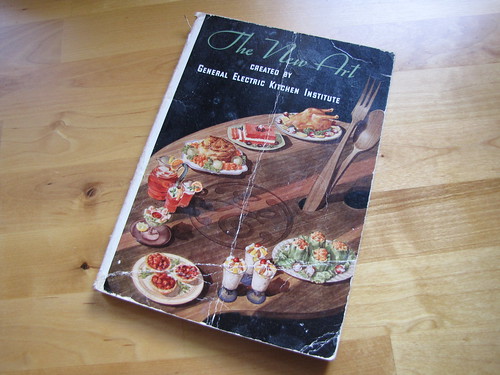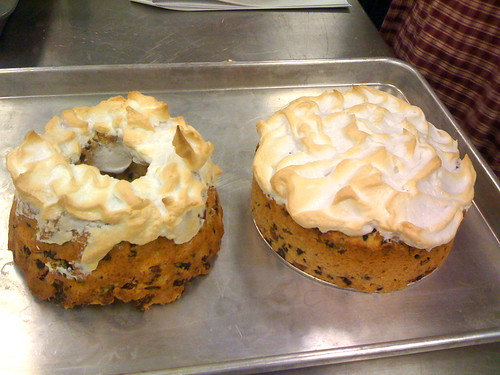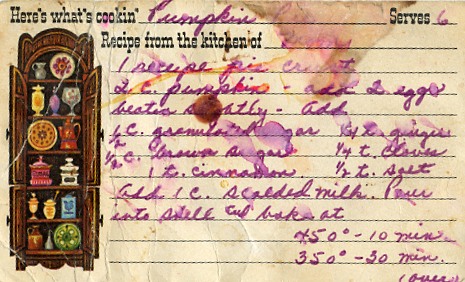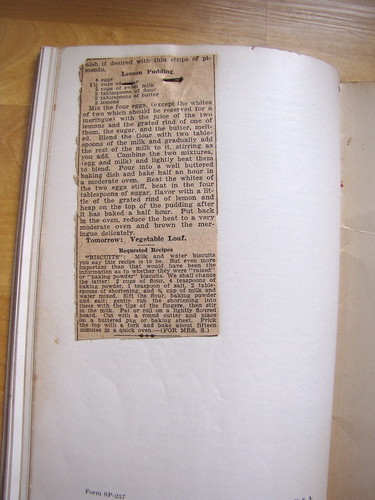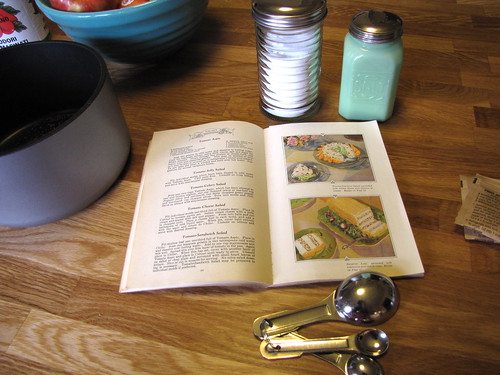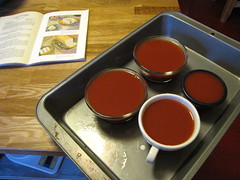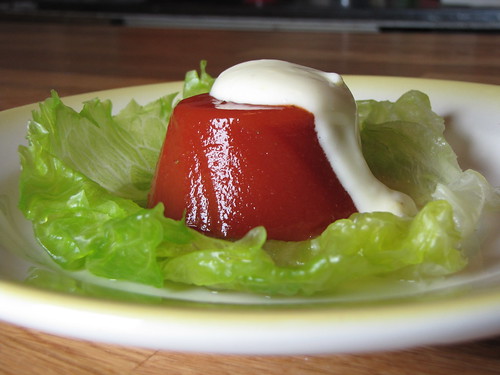The long-lost Golden Rod Cake
I was looking through a 1914 issue of The Boston Cooking School Magazine when this ad caught my eye:

A couple of interesting gadgets, there. That Roberts Lightning Mixer looks useful, and the mayonnaise mixer… well, you’d have to make a lot of mayonnaise to make that one worth taking up space in the kitchen, but if you do make a lot of mayo, I can see that it could be helpful.
But the one that mainly caught my attention is the one at the bottom of the page: “Golden Rod Cake Pan,” an oddly-shaped pan that appears to make triangular cakes. Since the inspiration for this blog, a year ago, was the similarly-named “Gold-n-Sno Cake,” I was particularly curious. What was the Golden Rod Cake?
A quick Google search turned up this post by the Old Foodie, who looked into the topic last year, complete with three interesting recipes.
Here are a couple more recipes for the Golden Rod Cake.
First, a very sparse recipe from A Collection of Delectable Recipes: Tried and True, 1898:
GOLDEN ROD CAKE.
Eighteen ounces powdered sugar, nine ounces butter, sixteen ounces eggs, one tablespoonful vanilla, one pennyweight soda, two pennyweights cream tartar, eighteen ounces pastry flour.
MRS F.C. CHANDLER.
No instructions whatsoever. No reference to the icing that many of the other recipes have. And no orange. Is this a related cake or something different?
Here’s a pair of recipes from Perfection in Baking, 1899. The first recipe is very close to Mrs. Chandler’s recipe, above. Perhaps we can assume that Mrs. Chandler just didn’t mention the orange icing because it was assumed that any reader would know that Golden Rod cakes would have orange icing.
Golden Rod Cake.
TO SELL AT 15 CENTS EACH.Cream together one pound of fine sugar with ten ounces of butter and one and a half pints eggs, one pennyweight of soda, one teaspoonful of vanilla, twenty ounces of cake flour, two pennyweights of cream of tartar. When baked, ice the sides with orange water icing.
Golden Rod Cake.
TO SELL AT TEN CENTS A PIECE.With one pound of butter and lard cream one and one half pounds of sugar, ten eggs, two thirds of a pint of milk, juice and grating of two oranges, two pounds of cake flour, one ounce of baking powder. Mix and bake like above. Ice some with orange, some strawberry, some chocolate. On one side ornament the name “Golden Rod” in different colors; that is, if cakes are frosted chocolate, ornament in yellow; if iced yellow, ornament in pink or white, etc.
(Further down on the same page, there is a recipe for Orange Slices cakes baked in a particular mold, and Orange Slice Cake is mentioned in the ad for the Golden Rod Cake Pan. Is this Orange Slices recipe what was meant?)
The Boston Cooking School offered the Golden Rod Cake Pan in the pages of their magazine, so it is no surprise that they had a recipe or two for it themselves. In 1904-1905, they gave us these two slightly different variations:
Goldenrod Cake for Charlotte Russe Moulds and Waldorf Triangles
Beat the yolks of six eggs very light. Gradually beat into these half a cup of sugar, then two tablespoonfuls of milk or orange juice, and, lastly, half a cup of sifted flour, sifted again with a level teaspoonful of baking powder and a few grains of salt. Fill the moulds or pans with a teaspoon, tapping the moulds on the table, to cause the mixture to settle to the bottom of the moulds. Bake in an oven a little hotter than for ordinary sponge cake, and turn the cake from the tins as soon as it is removed from the oven. Flavor with a grating of orange rind, or half a teaspoonful of vanilla extract. The recipe will make twelve triangles or charlotte russe cases. The mixture is finer-grained and more tender than the usual sponge cake. Cover the triangles with boiled frosting, and sprinkle with chopped pistachio nuts.
Goldenrod Cake for Charlotte Russe Moulds and Waldorf Triangles
Beat the yolks of six eggs very light. Gradually beat in half a cup of fine granulated sugar, then two tablespoonfuls of milk or orange juice (lemon juice will not do) and, lastly, half a cup and one tablespoonful (for difference in flour) of sifted flour, sifted again with a level teaspoonful of baking powder and a few grains of salt. Bake in an oven a little hotter than for ordinary sponge cake. Flavor with half a teaspoonful of vanilla extract or a grating of yellow orange rind.
Putting all this together, what we have is a fairly fine sponge cake, frequently with orange flavoring, shaped something like triangular ladyfingers, and sometimes used the same way (which might explain the lack of icing in Mrs. Chandler’s recipe—if you were making these for a Charlotte Russe, you wouldn’t need the icing).
I still don’t know the origin of the name, and I would really like to see how the Golden Rod cake was supposed to look. It would be fun to try to make them in the proper shape — does anyone know if pans like that still exist? I haven’t been able to find one.

